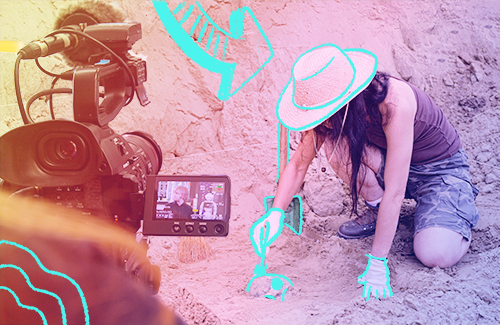
Students identify key claims in their stories and gather evidence to support those claims. No matter what type of news story students are making, every story makes claims. For a news story to have credibility, all claims made need to have support with evidence.
This lesson should be used as an activity after students have identified the main topic of their story and before they begin scripting and searching for experts to interview for their story.
When producing media, the ability to identify the claims you make gives students a clearer understanding of how to create credible work. When consuming media, identifying evidence and unfounded claims will make students more savvy about how credible a news story, documentary, or any other form of content is.
Understanding the difference between facts and opinions and supporting a claim to give it credibility is essential for writing and speaking in a professional setting. Learning to identify a claim and the process of supporting a claim will help students become better speakers and writers and better at identifying unfounded claims made by others. Recognizing when politicians make claims that are not supported by evidence is a key civic skill.
The availability of facts or information indicating whether a belief or proposition is true or valid
A person who has a comprehensive and authoritative knowledge of or skill in a particular area.
Something that is known or proved to be true.
A view or judgment formed about something, not necessarily based on fact or knowledge.
Historical inquiry is based on materials left from the past that can be studied and analyzed. (NCSS D2.His.9.9-12 - D2.His.13.9-12)
Determine the kinds of sources that will be helpful in answering compelling and supporting questions, taking into consideration multiple points of view represented in the sources, the types of sources available, and the potential uses of the sources. (NCSS D1.5.9-12)
Explain points of agreement and disagreement experts have about interpretations and applications of disciplinary concepts and ideas associated with a supporting question and explain how supporting questions contribute to an inquiry and how, through engaging source work, new compelling and supporting questions emerge. (NCSS D1.3.9-12 - D1.4.9-12)
Students leverage technology to take an active role in choosing, achieving and demonstrating competency in their learning goals, informed by the learning sciences. (ISTE)
Students critically curate a variety of resources using digital tools to construct knowledge, produce creative artifacts and make meaningful learning experiences for themselves and others. (ISTE)
Whether students are constructing opinions, explanation, or arguments, they will gather information from a variety of sources and evaluate the relevance of that information. (NCSS D3.1.9-12 - D3.2.9-12)
Explain how a question reflects an enduring issue in the field and explain points of agreement and disagreement experts have about interpretations and applications of disciplinary concepts and ideas associated with a compelling question. (NCSS D1.1.9-12 - D1.2.9-12)
Historical understanding requires recognizing this multiplicity of points of view in the past, which makes it important to seek out a range of sources on any historical question rather than simply use those that are easiest to find. It also requires recognizing that perspectives change over time, so that historical understanding requires developing a sense of empathy with people in the past whose perspectives might be very different from those of today. (NCSS D2.His.4.9-12 - D2.His.8.9-12)
Journalism
Media Literacy
Digital Literacy/Citizenship
STEM
Lessons
Beginner
Intermediate
Advanced
White board, chalkboard or other visual board
Computers
Mobile Phone
Internet
Notebook
50 Minutes
Now that we have tons of interesting information from our curiosity research, we will focus on answering our story’s central questions with claims, which are statements that need to be supported by evidence.
Using their pitch sheets and curiosity research notes, have students complete Evidence Chart Worksheet.
Before students start, review the following goals:
If students have decided an expert interview would benefit their story, here are a few suggested steps to identify who to interview.
Discuss how curiosity, research and collecting evidence are three elements that are critical to journalism. Identify an expert related to your story and prepare for the interview by drafting questions. Prompt students by asking:
If you can’t answer “why should I care?” then move to another story idea.
Uncertainty can make you uncomfortable, but looking closely at claims is an important part of understanding the information we all rely on. What can you do to identify and question the claims you see on social media?
What are the five different types of evidence you can use in a video story?
In two sentences, describe how your story changed during this activity.